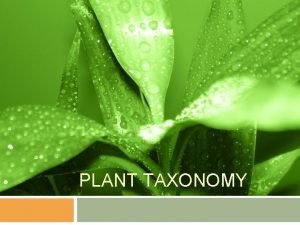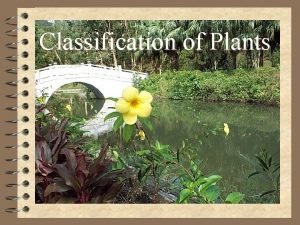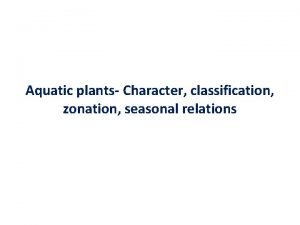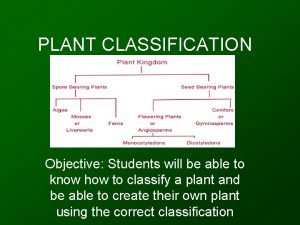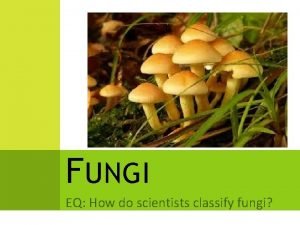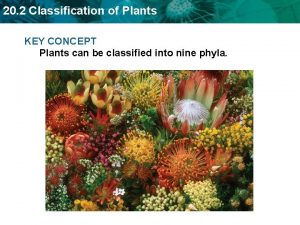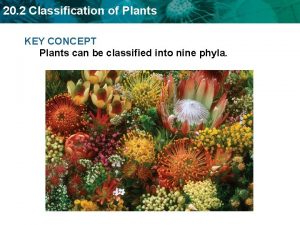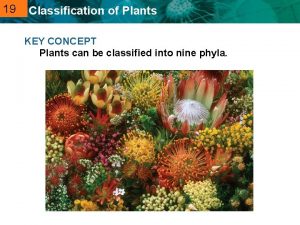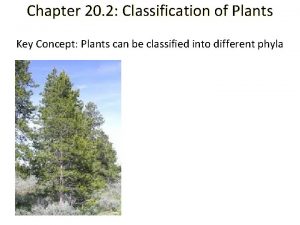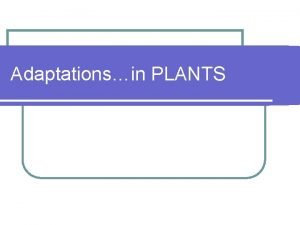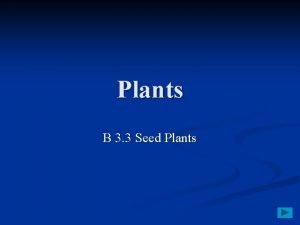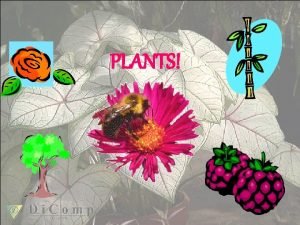20 2 Classification of Plants KEY CONCEPT Plants


















- Slides: 18

20. 2 Classification of Plants KEY CONCEPT Plants can be classified into nine phyla/divisions.

20. 2 Classification of Plants Land plants are classified by the presence or absence of vascular tissue and how they reproduce (with or without seeds) • “Vascular” – People: relating to vessels, especially those that carry blood. – Plants: relating to plant tissues that conduct water, sap, and nutrients.

20. 2 Classification of Plants Vascular Plants vs. Nonvascular Plants Vascular Nonvascular • Transport System – Leaves – True roots – Xylem – Phloem – Stems • Can grow tall • Live in dry areas • No Transport System – No roots (rhizoids) • Grow close to the ground to absorb water and nutrients • Live in moist areas *Complete Venn Diagram in notes

20. 2 Classification of Plants

20. 2 Classification of Plants Nonvascular Plants

20. 2 Classification of Plants Mosses and their relatives are seedless nonvascular plants. • Liverworts belong to phylum Hepatophyta. – often grow on wet rocks or in greenhouses – can be thallose or leafy

20. 2 Classification of Plants • Mosses belong to phylum Bryophyta. – most common seedless nonvascular plants – sphagnum moss commonly used by humans as “peat”

20. 2 Classification of Plants • Hornworts belong to phylum Anthocerophyta. – found in tropical forests and along streams – flat, lobed body with little green “horns”

20. 2 Classification of Plants Vascular Plants Seedless vs. w/Seeds

20. 2 Classification of Plants Club mosses and ferns are seedless vascular plants. • Club mosses belong to phylum Lycophyta. – not true mosses – oldest living group of vascular plants

20. 2 Classification of Plants • Ferns and their relatives belong to phylum Pterophyta. frond fiddlehead – whisk ferns and horsetails are close relatives of ferns – ferns have large leaves called fronds

20. 2 Classification of Plants Seed plants include cone-bearing plants and flowering plants. • Seed plants have several advantages over their seedless ancestors. – can reproduce without free-standing water, via pollination – seeds nourish and protect plant embryo – seeds allow plants to disperse to new places

20. 2 Classification of Plants • Gymnosperms do not have seeds enclosed in fruit. – most gymnosperms are cone-bearing. – the cone is reproductive structure of most gymnosperms. – pollen is produced in male cones. – eggs are produced in female cones. – seeds develop on scales of female cones.

20. 2 Classification of Plants • Cycads are gymnosperms in phylum Cycadophyta. – look like palm trees with large cones – grow in tropical areas

20. 2 Classification of Plants • Ginkgos are gymnosperms in phylum Ginkgophyta. – only one species alive today, Ginkgo biloba – grown in gardens and used in urban landscaping

20. 2 Classification of Plants • Conifers are gymnosperms in phylum Coniferophyta. – most common gymnosperms alive today – includes pines, spruce, cedar, fir, and juniper

20. 2 Classification of Plants • Angiosperms, or flowering plants, belong in phylum Anthophyta. • Angiosperms have seeds enclosed in some type of fruit. – A flower is the reproductive structure of angiosperms. – A fruit is a mature ovary of a flower.

20. 2 Classification of Plants Plant Classification Lab • Goal: Identify plants as either vascular or nonvascular based on microscope analysis. • This lab does not need to be a formal write up… only include the Title, Goal, and components listed below: – Draw image and label transport system components – Record slide name and number – Record as either vascular or nonvascular
 Chapter 4 lesson 4 metamorphic rocks answer key
Chapter 4 lesson 4 metamorphic rocks answer key Key concept builder lesson 1 what are waves answer key
Key concept builder lesson 1 what are waves answer key Business model example
Business model example Key partners key activities key resources
Key partners key activities key resources What non vascular plants
What non vascular plants Non vascular plants
Non vascular plants Flowering plants and non flowering plants similarities
Flowering plants and non flowering plants similarities Photosynthesis equation
Photosynthesis equation Real self versus ideal self
Real self versus ideal self Perbedaan pemasaran dan penjualan
Perbedaan pemasaran dan penjualan Classification of plants
Classification of plants Order of classification of plants
Order of classification of plants Characteristic of moss
Characteristic of moss Difference between spices and condiments
Difference between spices and condiments Classification of aquatic plants
Classification of aquatic plants Classification of plants
Classification of plants Basic classification of plants
Basic classification of plants Concept map of magma
Concept map of magma Concept map properties of matter
Concept map properties of matter











